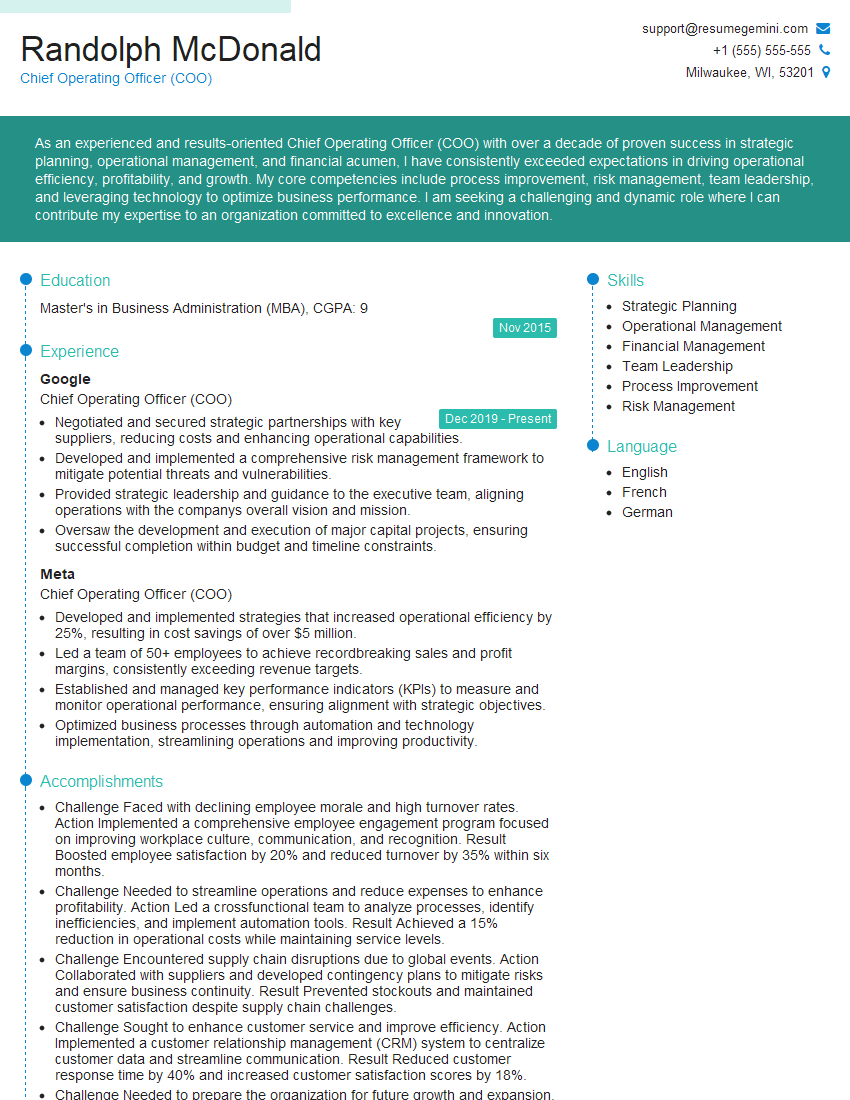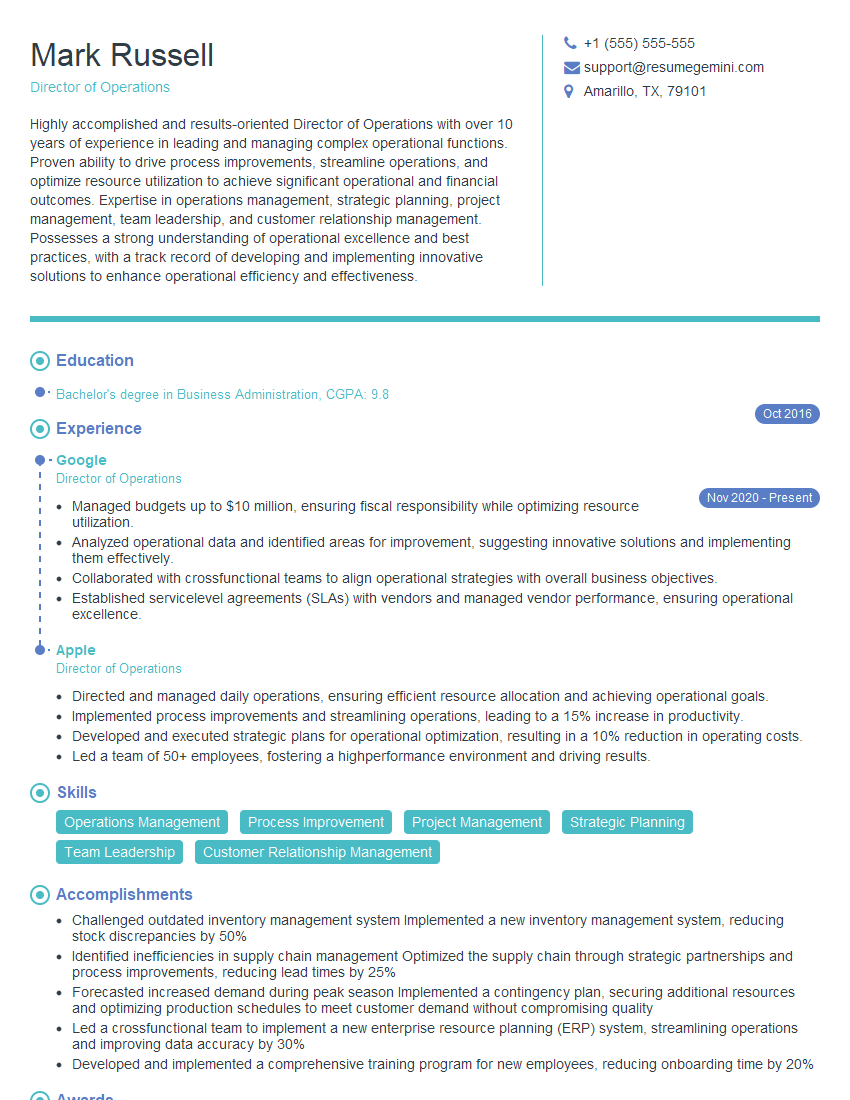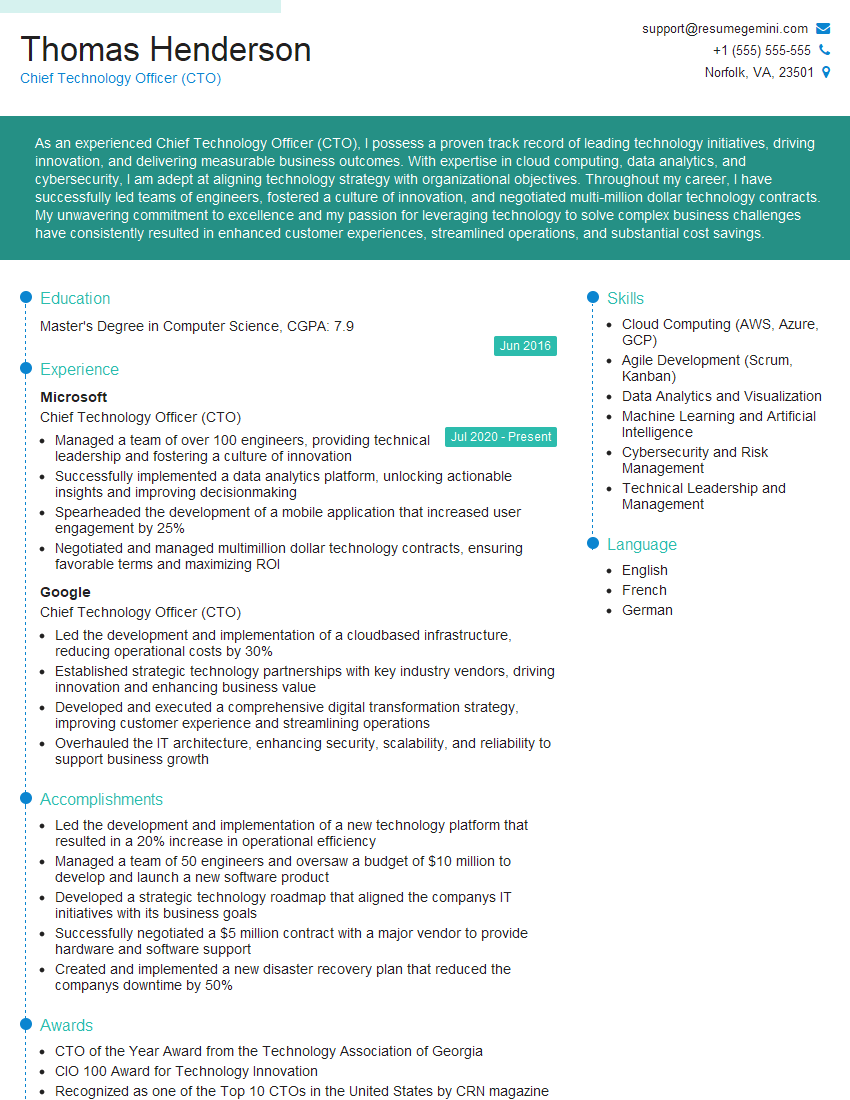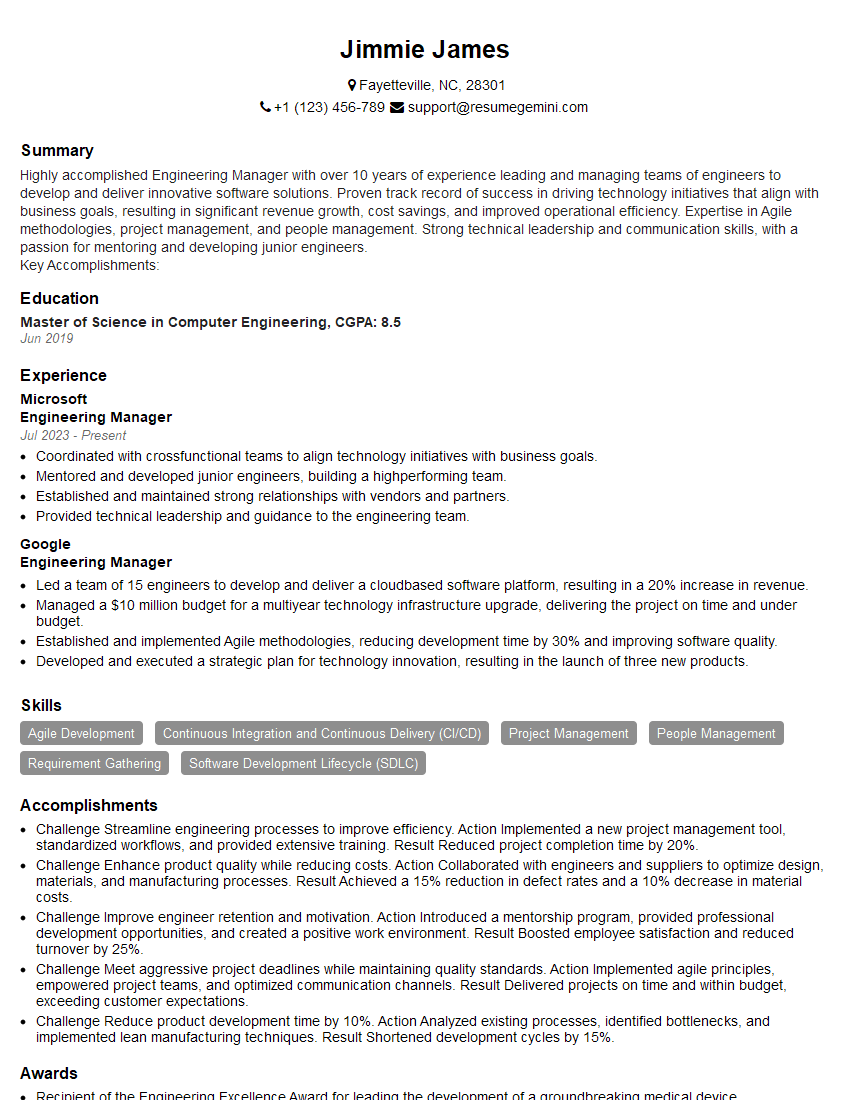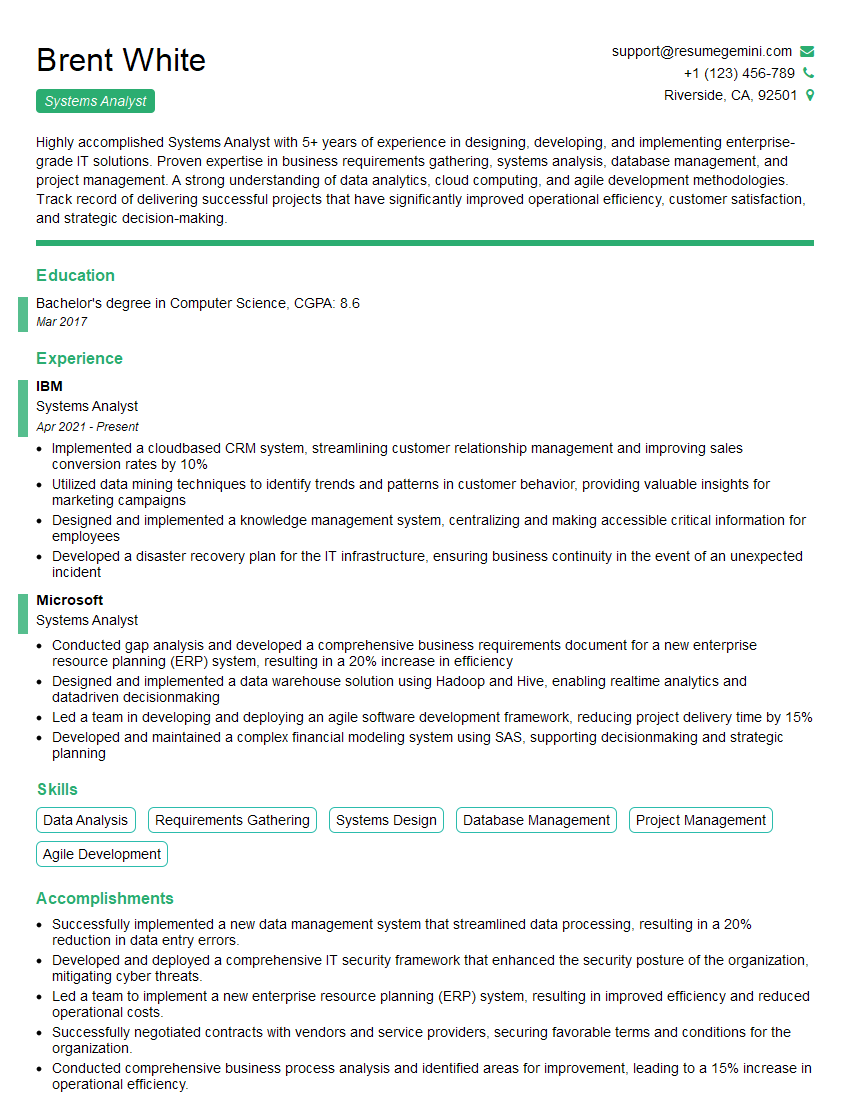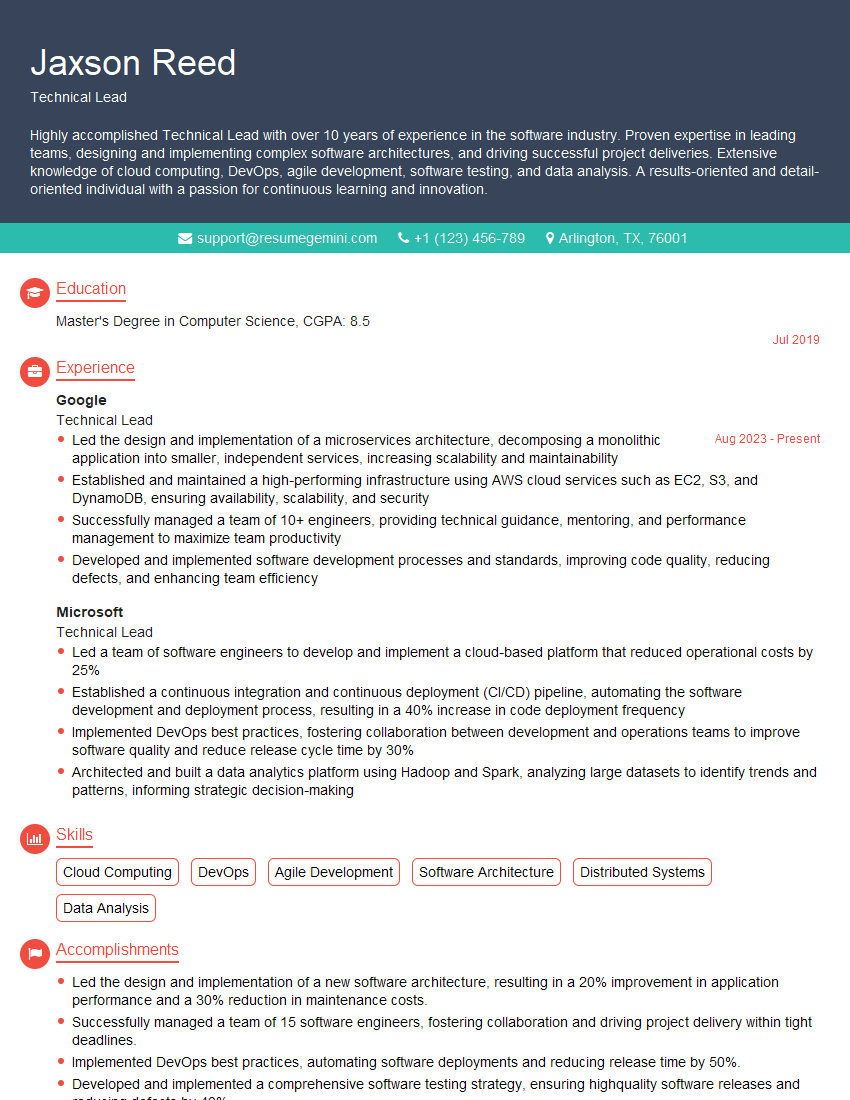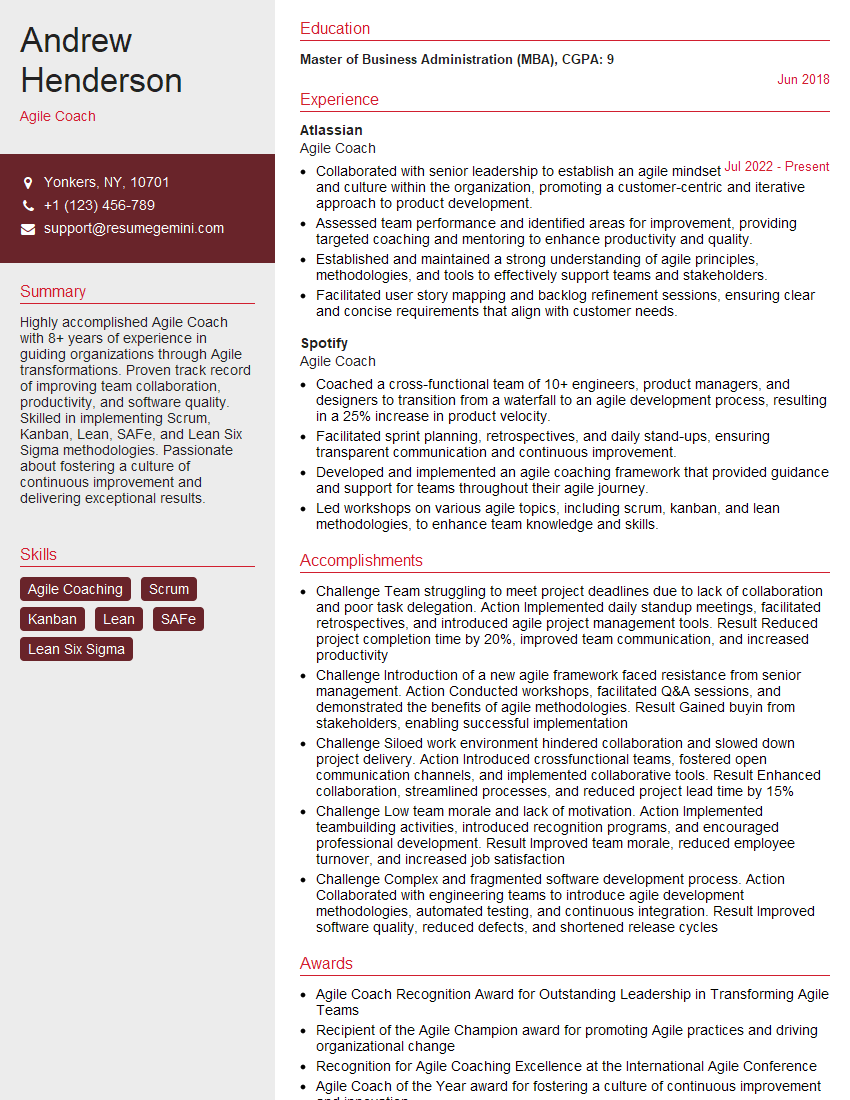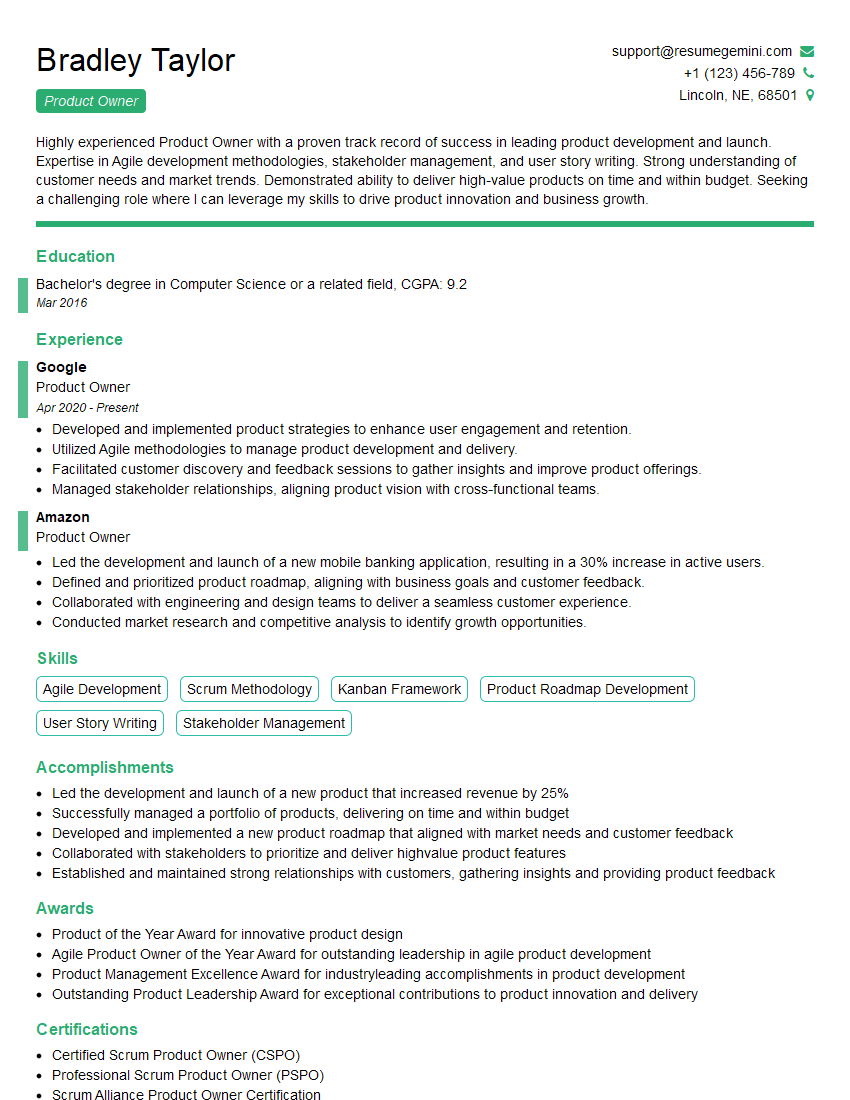The right preparation can turn an interview into an opportunity to showcase your expertise. This guide to Experience in working with multidisciplinary teams interview questions is your ultimate resource, providing key insights and tips to help you ace your responses and stand out as a top candidate.
Questions Asked in Experience in working with multidisciplinary teams Interview
Q 1. Describe your experience leading or participating in multidisciplinary projects.
Throughout my career, I’ve consistently worked on multidisciplinary projects, often leading teams or playing a pivotal role. For example, in my previous role at Acme Corp, I led a team of 15 individuals – including engineers, designers, marketers, and data scientists – to develop a new SaaS platform. My role involved defining the project scope, allocating resources, setting milestones, and ensuring cross-functional collaboration. Another significant project involved a complete overhaul of our company’s internal communication system, requiring close collaboration with IT, HR, and various departmental representatives. This demanded a deep understanding of diverse perspectives and needs to achieve a unified outcome.
- Project 1 (SaaS Platform): Successfully launched a new platform on time and within budget, exceeding initial user adoption targets.
- Project 2 (Internal Communication System): Implemented a new system that improved internal communication efficiency by 30%, as measured by employee satisfaction surveys and reduced internal email volume.
Q 2. How do you ensure effective communication within a multidisciplinary team?
Effective communication in a multidisciplinary team is paramount. I believe in a multi-pronged approach. First, I establish clear communication channels and protocols early on. This includes regular team meetings, utilizing project management software for updates and task assignments, and ensuring everyone understands their roles and responsibilities. Second, I promote open and transparent communication. I encourage active listening and feedback from all team members, regardless of their discipline. Third, I tailor my communication style to the audience. I avoid jargon and ensure everyone understands the information being shared. Finally, I actively foster a culture of respect and inclusivity, ensuring that everyone feels comfortable expressing their opinions and concerns.
For instance, in the SaaS project, we used a combination of daily stand-up meetings, weekly progress reports, and a dedicated Slack channel for quick questions and updates. This allowed for both structured communication and informal knowledge sharing.
Q 3. What strategies do you use to manage conflicts within a multidisciplinary team?
Conflict is inevitable in multidisciplinary teams due to varying perspectives and priorities. My approach involves proactive conflict management. I address conflicts early, before they escalate. This involves active listening to understand each party’s concerns and perspectives. Then, I facilitate a constructive dialogue to find common ground. I often use collaborative problem-solving techniques, focusing on finding solutions that meet everyone’s needs to the extent possible. If the conflict involves strong emotions, I might suggest a mediation process or seek guidance from HR if needed. My goal is always to resolve conflicts fairly and efficiently, maintaining a positive and productive team environment.
In the internal communication system project, a disagreement arose between the IT and HR teams about the system’s data privacy features. By facilitating a joint meeting and clarifying everyone’s concerns, we were able to find a solution that satisfied both departments’ security and usability requirements.
Q 4. Explain how you’ve resolved disagreements between team members from different disciplines.
Disagreements between team members from different disciplines often stem from differing priorities and perspectives. I’ve successfully resolved these by focusing on shared goals and finding common ground. This typically involves clearly articulating the overall project objectives and helping each discipline understand how their contribution fits into the larger picture. I then use data and evidence to support my arguments and help different disciplines see the value of compromise. Sometimes, it’s necessary to revisit the initial project plan or adjust priorities based on new insights or unforeseen challenges.
In the SaaS platform project, a disagreement arose between the designers and engineers about the feasibility of a specific design element. By having them present their arguments with data and user testing results, we were able to find a compromise that maintained the design’s aesthetic appeal while ensuring technical feasibility.
Q 5. Describe a time you had to negotiate priorities between different team members with conflicting needs.
Negotiating priorities is a common challenge in multidisciplinary projects. I usually employ a structured approach. First, I clearly define the project scope and goals and ensure all stakeholders understand them. Second, I gather input from each team member about their priorities and constraints. Third, I facilitate a collaborative prioritization exercise. This might involve using techniques like MoSCoW analysis (Must have, Should have, Could have, Won’t have) or weighted scoring to rank tasks based on their importance and urgency. Finally, I communicate the final prioritized list to the team, ensuring everyone understands the rationale behind the decisions. Transparency and clear communication are crucial in this process.
In the SaaS project, marketing wanted to launch quickly for a key marketing event, while engineering required more time for testing. By using a MoSCoW analysis and collaborative discussion, we prioritized essential features for the launch, delaying less critical functionalities.
Q 6. How do you identify and leverage the unique strengths of each discipline within a team?
Identifying and leveraging unique strengths is key to team success. I start by getting to know each team member’s expertise and experience during the initial project kick-off. This often involves individual one-on-one meetings to better understand their backgrounds and preferred work styles. Then, I create opportunities for each discipline to contribute their unique skills. For example, I might task the designers with user interface/user experience (UI/UX) design, engineers with the technical implementation, and marketers with the go-to-market strategy. This approach ensures that each member’s skills are utilized effectively, and overall project quality is improved.
In the internal communication project, the HR team’s expertise in employee behavior and communication preferences was crucial in designing the system’s user interface to ensure high user engagement.
Q 7. How do you facilitate collaboration and knowledge sharing across different disciplines?
Facilitating collaboration and knowledge sharing across disciplines is essential for success. I use several strategies to achieve this. Firstly, I conduct regular cross-functional workshops to allow team members from different disciplines to share their insights and perspectives. Secondly, I create opportunities for informal knowledge sharing, such as social events or casual team lunches. Thirdly, I leverage technology to facilitate collaboration. This includes using shared project management tools, online document repositories, and communication platforms to ensure easy access to information and efficient communication among team members. Finally, I encourage a culture of learning and mentorship. I encourage senior team members to mentor junior colleagues and support cross-functional knowledge transfer.
In the SaaS project, we held weekly knowledge-sharing sessions where team members from different disciplines could present their work, ask questions, and learn from each other’s expertise. This fostered a culture of collaboration and helped break down silos between different departments.
Q 8. What tools or methodologies have you used to enhance collaboration in multidisciplinary teams?
Enhancing collaboration in multidisciplinary teams requires a multifaceted approach. I’ve found success using a combination of tools and methodologies focusing on communication, transparency, and shared understanding. These include:
Project Management Software: Tools like Jira, Asana, or Trello facilitate task assignment, progress tracking, and communication within the team. These platforms allow for centralized documentation and visibility of everyone’s work, minimizing misunderstandings.
Communication Platforms: Regular use of Slack, Microsoft Teams, or similar platforms ensures constant, quick communication, and fosters a sense of community. We often use dedicated channels for specific tasks or discussions to keep things organized.
Collaborative Document Editing: Tools like Google Docs or Microsoft Office 365 allow for simultaneous editing and feedback on documents, fostering real-time collaboration and minimizing version control issues.
Regular Meetings: Structured meetings—daily stand-ups, weekly progress meetings, and bi-weekly review sessions—keep everyone aligned and allow for proactive issue resolution. Agendas are crucial to ensure productive use of everyone’s time.
Visual Collaboration Tools: Miro or Mural boards enable visual brainstorming, mapping out project workflows, and tracking progress in a dynamic way, helping to bridge communication gaps across different disciplines.
The key is choosing the right combination based on team size, project complexity, and individual team member preferences.
Q 9. Describe your experience with Agile or other collaborative project management methodologies.
My experience with Agile methodologies, particularly Scrum, has been extensive and highly successful. I’ve been involved in numerous projects employing Scrum’s iterative approach, focusing on sprints (typically 2-4 weeks) to deliver incremental value.
In a recent project developing a new mobile app, we used Scrum effectively. Daily stand-up meetings kept us aligned on daily tasks, sprint reviews ensured alignment with the product owner’s vision, and sprint retrospectives provided valuable feedback for process improvements. We used Jira to track our sprints, tasks, and bugs. This allowed for transparent progress tracking and facilitated quick identification and resolution of impediments.
The Agile framework’s adaptability to changing requirements was crucial; we accommodated shifting priorities and unexpected challenges smoothly. This iterative development approach, with constant feedback loops, ensured we delivered a high-quality product that met user needs.
Q 10. How do you ensure all team members understand project goals and their individual roles?
Ensuring everyone understands project goals and their roles is paramount. I employ a multi-pronged approach:
Clearly Defined Project Charter: A detailed document outlining the project goals, objectives, deliverables, timelines, and individual responsibilities is created collaboratively at the beginning of the project. This charter serves as a central reference point throughout the project lifecycle.
Kick-off Meeting: A thorough kickoff meeting clarifies project expectations and ensures everyone understands their roles and contributions. This meeting also facilitates team bonding and establishes clear communication channels.
Role-Specific Onboarding: Providing tailored onboarding materials and training for each role helps team members quickly grasp their responsibilities and how their work contributes to the broader project objectives.
Regular Communication and Feedback: Maintaining open communication channels—through regular meetings, updates, and feedback sessions—reinforces understanding and allows for early identification and resolution of any misunderstandings.
Visual Aids: Relying on visual aids like flowcharts, diagrams, and Gantt charts helps to explain complex processes and clearly show how each role fits into the overall project.
This comprehensive strategy ensures everyone is on the same page, fostering a collaborative and productive work environment.
Q 11. Describe a situation where you had to adapt your communication style to effectively work with diverse team members.
In a project involving engineers, designers, and marketing professionals, I encountered communication style differences. Engineers favored concise, data-driven communication, while designers preferred more visual and collaborative discussions. Marketing professionals focused on the strategic implications and potential ROI.
To bridge this gap, I adapted my communication style to suit each audience. With engineers, I used clear, technical specifications and data to support my points. With designers, I focused on visual representations of ideas and encouraged collaborative brainstorming sessions. When interacting with marketing, I highlighted the project’s strategic importance and potential market impact. I also utilized diverse communication tools such as emails for formal updates, instant messaging for quick questions, and regular team meetings to foster discussion and understanding. This flexible approach ensured that everyone felt heard and understood, promoting effective teamwork.
Q 12. How do you measure the success of a multidisciplinary project?
Measuring the success of a multidisciplinary project requires a holistic approach, going beyond simply meeting deadlines. I consider several key metrics:
On-Time and On-Budget Delivery: Meeting the project’s timeline and budget constraints is a fundamental measure of success.
Quality of Deliverables: Assessing the quality of the final product or service against pre-defined quality standards is essential. This could involve user testing, code reviews, or design critiques, depending on the project.
Achievement of Project Goals: Measuring the extent to which the project achieved its stated objectives is crucial. This may involve analyzing key performance indicators (KPIs) specific to the project’s goals.
Team Satisfaction and Collaboration: Assessing team morale and collaboration effectiveness is vital for long-term success. This can be done through feedback surveys or team retrospectives.
Client Satisfaction: Gathering feedback from clients and stakeholders ensures the project met their expectations and provides valuable insights for future projects.
Using a combination of quantitative and qualitative data from these areas provides a comprehensive evaluation of the project’s success.
Q 13. How do you handle situations where a team member is underperforming or not contributing effectively?
Addressing underperformance requires a sensitive yet firm approach. I follow a structured process:
Private Conversation: I initiate a private conversation with the underperforming team member to understand the root cause. This could involve personal issues, skill gaps, or unclear expectations. Active listening is key here.
Collaboration and Support: Once the issue is understood, I work collaboratively with the team member to develop a plan to address it. This may involve providing additional training, reassigning tasks, or offering mentorship.
Monitoring and Feedback: Regularly monitor progress and provide constructive feedback. Celebrate small wins to maintain motivation and build confidence.
Documentation: Keep detailed records of conversations and agreed-upon actions. This documentation is crucial if further intervention is needed.
Escalation if Necessary: If the situation doesn’t improve despite support and interventions, escalation to management might be necessary to explore alternative solutions.
The goal is not to punish, but to support the individual and ultimately benefit the entire team.
Q 14. How do you deal with differing opinions or approaches from different disciplines within a project?
Handling differing opinions is inherent in multidisciplinary projects. I leverage these differences to foster innovation and create better solutions. My approach involves:
Respectful Dialogue: Creating a safe space for open and respectful dialogue where everyone feels comfortable expressing their views.
Active Listening: Actively listening to understand each discipline’s perspective and identifying the underlying rationale behind different approaches. This often reveals common goals that were obscured by differences in terminology or approach.
Data-Driven Decision Making: When possible, using data and evidence to support decisions. This helps shift the discussion from opinions to facts.
Compromise and Collaboration: Facilitating compromise and collaboration to find solutions that integrate the best aspects of different approaches. This might involve creating a hybrid solution that incorporates elements from various disciplines.
Mediation if Necessary: If disagreements escalate, acting as a mediator to facilitate a constructive resolution. This involves helping team members understand each other’s viewpoints and find common ground.
By embracing diverse perspectives and fostering a collaborative environment, I transform potential conflict into opportunities for innovative problem-solving.
Q 15. Describe your experience with risk management in multidisciplinary projects.
Risk management in multidisciplinary projects requires a proactive and collaborative approach. It’s not just about identifying potential problems; it’s about understanding how those problems might interact across different disciplines and mitigating their impact on the overall project goals. My approach begins with a comprehensive risk assessment, involving representatives from each discipline. We brainstorm potential risks, categorizing them by likelihood and impact. This often involves using a risk matrix, visually representing risks on a graph based on probability and severity.
For instance, in a software development project with a hardware component, a risk might be delays in hardware delivery impacting software testing. We would collaboratively determine the likelihood of this delay and its potential impact (e.g., project deadline slippage, budget overruns). We then develop mitigation strategies – perhaps by engaging a secondary hardware supplier or building in buffer time to the schedule. These mitigation strategies are documented and regularly reviewed throughout the project lifecycle. Post-project reviews are also crucial for refining our risk assessment processes and identifying areas for improvement.
Career Expert Tips:
- Ace those interviews! Prepare effectively by reviewing the Top 50 Most Common Interview Questions on ResumeGemini.
- Navigate your job search with confidence! Explore a wide range of Career Tips on ResumeGemini. Learn about common challenges and recommendations to overcome them.
- Craft the perfect resume! Master the Art of Resume Writing with ResumeGemini’s guide. Showcase your unique qualifications and achievements effectively.
- Don’t miss out on holiday savings! Build your dream resume with ResumeGemini’s ATS optimized templates.
Q 16. How do you ensure the integration of different disciplines’ work into a cohesive whole?
Integrating diverse disciplines requires clear communication, well-defined interfaces, and a strong project management structure. I utilize a phased approach, starting with a detailed project plan that clearly outlines the dependencies between different disciplines. This plan includes key milestones, deliverables, and clear communication channels. Regular cross-functional meetings are vital, where teams can discuss progress, share information, and address any integration challenges. These meetings are not just status updates; they’re collaborative problem-solving sessions.
For example, in a construction project, the architectural, engineering, and construction teams need to be tightly integrated. We’d establish a common data environment (CDE) – a centralized repository for all project information – to ensure everyone is working from the same updated information. Using visual tools like Gantt charts and integrated project management software, we visualize the project schedule and dependencies, highlighting critical path activities that require close coordination. This proactive approach minimizes misunderstandings and ensures smooth integration.
Q 17. What are some common challenges you face when working with multidisciplinary teams, and how do you overcome them?
Common challenges in multidisciplinary teams include communication barriers, conflicting priorities, and differing work styles. Communication barriers can arise from using different jargon or having varying communication preferences. I address this by establishing clear communication protocols, using standardized terminology, and facilitating open dialogue. Conflicting priorities are handled through collaborative prioritization exercises, where we clearly define project goals and align individual team objectives accordingly.
Differing work styles require a flexible approach. I encourage team members to understand and appreciate each other’s perspectives, fostering a culture of mutual respect. We establish clear roles and responsibilities to avoid overlap and confusion. Regular feedback sessions, both individual and group, help address emerging conflicts and ensure everyone feels heard and valued. Active listening, empathy, and a focus on finding win-win solutions are crucial in overcoming these challenges.
Q 18. Describe a time you had to mediate a conflict between team members from different departments.
In a previous project, a conflict arose between the marketing and engineering teams regarding the release date of a new product. Marketing wanted an earlier launch date to capitalize on a market opportunity, while engineering argued that more time was needed to ensure product quality and stability. I mediated the conflict by facilitating a structured meeting where each team presented their perspective and supporting data. I actively listened to both sides, ensuring each team felt heard and understood.
I then guided them towards a collaborative solution by focusing on the shared goal: a successful product launch. We analyzed the potential risks of both early and late launches, weighing the marketing benefits against potential engineering challenges. Ultimately, we agreed on a compromise: a slightly delayed launch date, accompanied by an aggressive pre-launch marketing campaign to maintain momentum. This solution satisfied both teams and resulted in a successful product launch. The key was to focus on shared goals and find a solution that addressed the concerns of all parties.
Q 19. How do you foster a culture of trust and respect within a multidisciplinary team?
Fostering trust and respect requires intentional effort. I begin by establishing a culture of transparency and open communication. This involves clearly communicating project goals, progress updates, and any challenges encountered. I also ensure that team members have the opportunity to provide feedback and contribute to decision-making processes. Recognizing and celebrating individual and team achievements builds morale and strengthens relationships.
Team-building activities, both formal and informal, are also crucial. These activities can range from simple social gatherings to more structured workshops focused on communication and collaboration. I actively promote a culture of mutual respect and understanding by highlighting the value each discipline brings to the project. By modeling respectful behavior and actively addressing any instances of disrespect, I create an environment where trust and respect can thrive.
Q 20. How do you handle changing priorities or scope within a multidisciplinary project?
Handling changing priorities or scope requires a structured and flexible approach. First, I ensure that any changes are formally documented and communicated to all team members. We then collaboratively assess the impact of these changes on the project schedule, budget, and resources. This often involves updating the project plan and adjusting priorities accordingly. Transparency is vital to avoid confusion and maintain team morale.
For example, if a new requirement is added mid-project, we’d hold a meeting to assess its impact. This might involve evaluating the additional resources needed, the necessary schedule adjustments, and potential risks. We’d then formally document these changes, update the project plan, and re-evaluate resource allocation to accommodate the new requirement. Regular progress reviews and communication help us stay ahead of potential issues and adapt to evolving circumstances effectively.
Q 21. Describe your experience using project management software to manage multidisciplinary teams.
I have extensive experience using various project management software, including Jira, Asana, and Microsoft Project. These tools are invaluable for managing multidisciplinary teams, enabling efficient task assignment, progress tracking, and communication. In particular, I leverage their functionalities for collaborative task management, risk tracking, and reporting. For instance, Jira’s Kanban boards provide a visual representation of project workflow, allowing for easy monitoring of progress across different teams.
I also utilize these tools to create customized dashboards that provide real-time project insights to stakeholders. These dashboards often include key performance indicators (KPIs), such as task completion rates, budget tracking, and risk assessments. By using these tools effectively, we improve communication, enhance collaboration, and gain better control over project timelines and resources. Furthermore, the ability to integrate these tools with other software (such as communication platforms like Slack) helps in streamlining workflows.
Q 22. How do you ensure that all stakeholders are kept informed of the progress of the project?
Keeping all stakeholders informed is crucial for project success. My approach is multifaceted and relies on a combination of proactive communication and tailored reporting. This starts with defining communication channels and frequency at the project outset, ensuring everyone knows how and when they’ll receive updates.
Regular Status Meetings: Scheduled meetings with different stakeholder groups (e.g., executive sponsors, technical teams, clients) to present progress, address concerns, and gather feedback. Agendas are distributed in advance and minutes are circulated afterwards.
Project Management Software: Utilizing tools like Jira or Asana to provide real-time project visibility. Stakeholders can access dashboards to track progress, view timelines, and identify potential roadblocks. Permission levels are carefully managed to ensure data security and relevance.
Targeted Communication: Recognizing that not all stakeholders need the same level of detail, I tailor communication to their specific interests and technical expertise. For instance, executive summaries are sufficient for high-level stakeholders, while detailed reports are provided to technical leads.
Proactive Risk Management: Identifying and communicating potential risks early allows stakeholders to prepare for potential disruptions and make informed decisions. This ensures transparency and trust.
For example, during a recent software development project, I established a weekly email update for executive stakeholders summarizing key achievements and potential challenges. Simultaneously, the development team used Jira for daily updates, allowing for quicker response to emergent issues.
Q 23. How do you manage the expectations of different stakeholders with varying levels of technical expertise?
Managing expectations across diverse stakeholders requires clear, consistent, and tailored communication. Understanding the technical expertise of each stakeholder is paramount.
Level-Appropriate Communication: I avoid technical jargon when communicating with non-technical stakeholders. Instead, I use analogies and simple explanations to convey complex information. Visual aids, such as charts and diagrams, are also effective.
Regular Check-ins: Frequent check-ins, particularly during critical phases of the project, allow me to address concerns promptly and proactively manage expectations. This builds trust and fosters collaboration.
Documentation and Training: Providing clear, concise documentation and offering training sessions to help stakeholders understand the technical aspects of the project can improve comprehension and manage unrealistic expectations.
Realistic Timeline and Scope: Setting realistic expectations from the start by defining a clear project scope and timeline prevents future misunderstandings and disappointment.
In a past project involving a large-scale database migration, I created simple infographics explaining the migration process for executives, while detailed technical documentation was provided to the database administrators. This ensured that everyone understood their role and the project’s progress.
Q 24. How do you build consensus amongst team members with conflicting priorities?
Building consensus among team members with conflicting priorities often requires facilitating open communication and collaborative problem-solving.
Prioritization Workshops: Organizing workshops where team members can collaboratively identify and prioritize tasks based on project objectives and constraints. Techniques like MoSCoW (Must have, Should have, Could have, Won’t have) can be highly beneficial.
Conflict Resolution: Addressing conflicts directly in a neutral and respectful manner, facilitating open discussion, and actively listening to each team member’s perspective. The goal is to find common ground and mutually acceptable solutions.
Decision-Making Framework: Establishing a clear decision-making framework, including processes for escalating disagreements, ensures transparency and fairness. This could involve a voting system or a designated decision-maker.
Compromise and Negotiation: Encouraging compromise and negotiation to find solutions that balance the needs and priorities of different team members. This might involve re-scoping tasks or adjusting timelines.
For instance, in a project with competing deadlines for design and development, we used a prioritization workshop to identify critical features and re-allocate resources, resulting in a balanced and achievable project plan.
Q 25. Describe a time you had to make a difficult decision that impacted multiple disciplines within a team.
During the development of a new mobile application, we faced a significant delay in the backend development, impacting the testing and launch schedule of the front-end team. The decision to either delay the launch or release a minimally viable product (MVP) was critical.
After careful consideration of the potential risks and benefits of each option, including stakeholder input and risk assessment, I decided to release an MVP. This decision prioritized getting the app into the market quickly, gathering user feedback, and iterating based on real-world data. We communicated this decision transparently to all stakeholders, explaining the rationale and managing expectations. Although risky, the MVP allowed us to gather valuable early user feedback, leading to improvements in subsequent releases. It was a challenging decision because it meant deviating from the original plan, but it ultimately proved successful.
Q 26. How do you ensure that the project deliverables meet the needs of all stakeholders?
Ensuring project deliverables meet stakeholder needs requires a proactive and iterative approach.
Clearly Defined Requirements: Starting with clearly defined requirements, gathered through comprehensive stakeholder engagement (e.g., interviews, surveys, workshops). This ensures everyone is on the same page about the project’s goals and objectives.
Regular Feedback Loops: Incorporating regular feedback loops throughout the project lifecycle. This allows for early identification and resolution of any discrepancies between expectations and deliverables.
Prototyping and Testing: Utilizing prototyping and testing to validate that the deliverables meet stakeholder expectations before significant resources are invested. This includes user acceptance testing (UAT) to ensure the final product meets the intended purpose.
Change Management: Establishing a formal change management process to handle any necessary adjustments to requirements or deliverables during the project’s lifecycle. This prevents scope creep and maintains stakeholder satisfaction.
For example, in a website redesign project, we developed a prototype early in the process and shared it with stakeholders for feedback. This allowed us to identify usability issues and incorporate feedback before moving to full-scale development, ensuring the final product aligned perfectly with stakeholder needs.
Q 27. How do you adapt your leadership style to suit the needs of different team members and disciplines?
Adapting leadership style is essential for effectively managing multidisciplinary teams. My approach is based on understanding individual needs and team dynamics.
Situational Leadership: I use situational leadership, adjusting my style based on the individual’s experience, skills, and motivation. This might involve delegating tasks to experienced team members, providing guidance and support to those needing it, or offering challenging opportunities for growth.
Collaborative Leadership: I promote a collaborative environment where team members feel empowered to contribute and share their expertise. This includes active listening, valuing diverse perspectives, and fostering open communication.
Coaching and Mentoring: I actively coach and mentor team members, providing support and guidance to help them develop their skills and reach their full potential. This fosters team morale and improves overall performance.
Recognition and Appreciation: I regularly recognize and appreciate individual and team achievements, fostering a positive and motivated work environment. This motivates team members to perform at their best.
For instance, with a junior designer, I provided close guidance and feedback, while with a senior developer, I delegated significant responsibilities and encouraged their initiative.
Q 28. Describe your approach to managing dependencies between different disciplines within a project.
Managing dependencies between disciplines requires careful planning, clear communication, and proactive monitoring.
Dependency Mapping: Creating a clear dependency map that visually represents the relationships between different tasks and disciplines. This allows for early identification of potential bottlenecks and risks.
Critical Path Analysis: Conducting a critical path analysis to identify the most critical tasks and dependencies, allowing for focused resource allocation and risk mitigation.
Regular Communication and Coordination: Establishing regular communication channels between different disciplines to ensure timely updates and address any emerging issues. This might include daily stand-up meetings or weekly progress reports.
Buffer Time: Building buffer time into the schedule to account for unforeseen delays and dependencies. This provides flexibility and helps prevent project delays.
Risk Management: Proactively identifying and managing potential risks associated with dependencies, such as resource constraints or technical challenges. This might include developing contingency plans to address potential problems.
In a recent project, we used a Gantt chart to visualize the dependencies between design, development, and testing. This helped us identify a potential bottleneck and allocate additional resources to the design phase, preventing delays in subsequent stages.
Key Topics to Learn for Experience in working with Multidisciplinary Teams Interview
- Understanding Team Dynamics: Learn to identify different communication styles and working preferences within a multidisciplinary team. Consider how personality types and skill sets impact collaboration.
- Effective Communication Strategies: Explore techniques for clear and concise communication across disciplines. Practice active listening and conflict resolution strategies. Consider the importance of both verbal and written communication.
- Collaboration & Problem-Solving: Discuss your experience working collaboratively on complex projects, navigating differing perspectives to achieve a shared goal. Highlight problem-solving approaches that leverage the diverse expertise within the team.
- Project Management in Multidisciplinary Settings: Explain your understanding of project management methodologies and how you’ve applied them to coordinate efforts within a multidisciplinary team. Focus on your role in planning, execution, and monitoring progress.
- Leveraging Diverse Expertise: Describe how you’ve identified and utilized the unique skills and knowledge of team members from different backgrounds to enhance project outcomes. Showcase examples of successful teamwork where different perspectives were crucial.
- Navigating Conflicts and Challenges: Discuss instances where disagreements arose within a multidisciplinary team and how you contributed to resolving conflicts constructively. Highlight your ability to mediate and find common ground.
- Contribution and Accountability: Articulate how you effectively contribute to a team while also understanding your individual responsibilities and maintaining accountability for your assigned tasks.
Next Steps
Mastering collaboration within multidisciplinary teams is crucial for career advancement in today’s dynamic work environment. Employers highly value candidates who can effectively navigate complex projects and contribute to a team’s overall success. To significantly boost your job prospects, focus on creating an ATS-friendly resume that clearly showcases your experience and skills in this area. ResumeGemini is a trusted resource to help you build a professional and impactful resume. We provide examples of resumes tailored to highlight “Experience in working with multidisciplinary teams,” ensuring your application stands out. Take the next step towards your dream job – build a winning resume today.
Explore more articles
Users Rating of Our Blogs
Share Your Experience
We value your feedback! Please rate our content and share your thoughts (optional).
What Readers Say About Our Blog
Hello,
We found issues with your domain’s email setup that may be sending your messages to spam or blocking them completely. InboxShield Mini shows you how to fix it in minutes — no tech skills required.
Scan your domain now for details: https://inboxshield-mini.com/
— Adam @ InboxShield Mini
Reply STOP to unsubscribe
Hi, are you owner of interviewgemini.com? What if I told you I could help you find extra time in your schedule, reconnect with leads you didn’t even realize you missed, and bring in more “I want to work with you” conversations, without increasing your ad spend or hiring a full-time employee?
All with a flexible, budget-friendly service that could easily pay for itself. Sounds good?
Would it be nice to jump on a quick 10-minute call so I can show you exactly how we make this work?
Best,
Hapei
Marketing Director
Hey, I know you’re the owner of interviewgemini.com. I’ll be quick.
Fundraising for your business is tough and time-consuming. We make it easier by guaranteeing two private investor meetings each month, for six months. No demos, no pitch events – just direct introductions to active investors matched to your startup.
If youR17;re raising, this could help you build real momentum. Want me to send more info?
Hi, I represent an SEO company that specialises in getting you AI citations and higher rankings on Google. I’d like to offer you a 100% free SEO audit for your website. Would you be interested?
Hi, I represent an SEO company that specialises in getting you AI citations and higher rankings on Google. I’d like to offer you a 100% free SEO audit for your website. Would you be interested?
good
